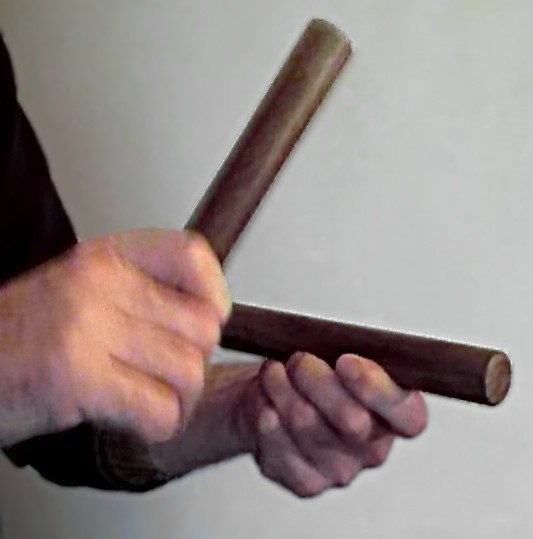|
Los Muñequitos De Matanzas
Los Muñequitos de Matanzas is a Cuban rumba ensemble from the city of Matanzas. The group was established in 1952 as Conjunto Guaguancó Matancero and released their first LP in 1956 through Puchito. Since then, Los Muñequitos have continued to perform and record, becoming one of the most successful and critically acclaimed rumba groups of all time. History On October 9, 1952 in the barrio of La Marina, city of Matanzas, Cuba, a group of young rumberos stopped off at their local tavern El Gallo after work. While unwinding over drinks, a song by Arsenio Rodríguez came on the bar’s record player. The drummers began accompanying the song by playing on the counter, on glasses and bottles, using whatever items were at hand. Their performance so impressed the other customers, as well as passers-by, that the men received applause when the song and their accompaniment concluded. It was at that moment when one of the men suggested they form a rumba group to perform at local venues. It ... [...More Info...] [...Related Items...] OR: [Wikipedia] [Google] [Baidu] |
Cuba
Cuba, officially the Republic of Cuba, is an island country, comprising the island of Cuba (largest island), Isla de la Juventud, and List of islands of Cuba, 4,195 islands, islets and cays surrounding the main island. It is located where the northern Caribbean Sea, Gulf of Mexico, and Atlantic Ocean meet. Cuba is located east of the Yucatán Peninsula (Mexico), south of both Florida and the Bahamas, west of Hispaniola (Haiti/Dominican Republic), and north of Jamaica and the Cayman Islands. Havana is the largest city and capital. Cuba is the List of countries and dependencies by population, third-most populous country in the Caribbean after Haiti and the Dominican Republic, with about 10 million inhabitants. It is the largest country in the Caribbean by area. The territory that is now Cuba was inhabited as early as the 4th millennium BC, with the Guanahatabey and Taino, Taíno peoples inhabiting the area at the time of Spanish colonization of the Americas, Spanish colonization ... [...More Info...] [...Related Items...] OR: [Wikipedia] [Google] [Baidu] |
Palo (religion)
Palo, also known as Las Reglas de Congo, is an African diasporic religion that developed in Cuba during the late 19th or early 20th century. It draws heavily upon the traditional Kongo religion of Central Africa, with additional influences taken from Catholicism and from Spiritism. An initiatory religion practised by ''paleros'' (male) and ''paleras'' (female), Palo is organised through small autonomous groups called ''munanso congo'', each led by a ''tata'' (father) or ''yayi'' (mother). Although teaching the existence of a creator divinity, commonly called Nsambi, Palo regards this entity as being uninvolved in human affairs and instead focuses its attention on the spirits of the dead. Central to Palo is the ''nganga'', a vessel usually made from an iron cauldron. Many ''nganga'' are regarded as material manifestations of ancestral or nature deities known as ''mpungu''. The ''nganga'' will typically contain a wide range of objects, among the most important being sticks and h ... [...More Info...] [...Related Items...] OR: [Wikipedia] [Google] [Baidu] |
Rumba Quinto Modes
The term rumba may refer to a variety of unrelated music styles. Originally, "rumba" was used as a synonym for "party" in northern Cuba, and by the late 19th century it was used to denote the complex of secular music styles known as Cuban rumba. Since the early 20th century the term has been used in different countries to refer to distinct styles of music and dance, most of which are only tangentially related to the original Cuban rumba, if at all. The vague etymological origin of the term rumba, as well as its interchangeable use with guaracha in settings such as bufo theatre, is largely responsible for such worldwide polysemy of the term. In addition, "rumba" was the primary marketing term for Cuban music in North America, as well as West and Central Africa, during much of the 20th century, before the rise of mambo, pachanga and salsa. "Rumba" entered the English lexicon in the early 20th century, at least as early as 1919, and by 1935 it was used as a verb to denote the bal ... [...More Info...] [...Related Items...] OR: [Wikipedia] [Google] [Baidu] |
Clave (rhythm)
The clave (; ) is a rhythmic pattern used as a tool for meter (music), temporal organization in Brazilian and Afro-Cuban music, Cuban music. In Spanish, ''clave'' literally means key, clef, code, or keystone. It is present in a variety of genres such as Abakuá music, Cuban rumba, rumba, conga (music), conga, son (music), son, mambo (music), mambo, Salsa music, salsa, songo music, songo, timba and Afro-Cuban jazz. The five-drum stroke, stroke clave pattern represents the structural core of many Cuban rhythms. The study of rhythmic methodology, especially in the context of Afro-Cuban jazz, Afro-Cuban music, and how it influences the Music and emotion, mood of a piece is known as clave theory. The clave pattern originated in sub-Saharan African music traditions, where it serves essentially the same function as it does in Cuba. In ethnomusicology, clave is also known as a ''key pattern'', ''guide pattern'', ''phrasing referent'', ''timeline'', or ''asymmetrical timeline''. The clav ... [...More Info...] [...Related Items...] OR: [Wikipedia] [Google] [Baidu] |
Timba
Timba is a Cuban genre of music based on Cuban '' son'' with '' salsa'', American Funk/R&B and the strong influence of Afro-Cuban folkloric music. Timba rhythm sections differ from their salsa counterparts, because timba emphasizes the bass drum, which is not used in salsa bands. Timba and salsa use the same tempo range and they both use the standard conga marcha. Almost all timba bands have a trap drummer. Timbas also often break the basic tenets of arranging the music in- clave. Timba is considered to be a highly aggressive type of music, with rhythm and "swing" taking precedence over melody and lyricism. Associated with timba is a radically sexual and provocative dance style known as despelote (literally meaning chaos or frenzy). It is a dynamic evolution of salsa, full of improvisation and Afro Cuban heritage, based on son, Rumba and mambo, taking inspiration from Latin jazz, and is highly percussive with complex sections. Timba is more flexible than salsa and includes a mo ... [...More Info...] [...Related Items...] OR: [Wikipedia] [Google] [Baidu] |
Havana
Havana (; ) is the capital and largest city of Cuba. The heart of La Habana Province, Havana is the country's main port and commercial center.Cuba ''The World Factbook''. Central Intelligence Agency. It is the most populous city, the largest by area, and the List of metropolitan areas in the West Indies, second largest metropolitan area in the Caribbean region. The population in 2012 was 2,106,146 inhabitants, and its area is for the capital city side and 8,475.57 km2 for the metropolitan zone. Its official population was 1,814,207 inhabitants in 2023. Havana was founded by the Spanish Empire, Spanish in the 16th century. It served as a springboard for the Spanish colonization of the Americas, Spanish conquest of ... [...More Info...] [...Related Items...] OR: [Wikipedia] [Google] [Baidu] |
Grammy Award
The Grammy Awards, stylized as GRAMMY, and often referred to as The Grammys, are awards presented by The Recording Academy of the United States to recognize outstanding achievements in music. They are regarded by many as the most prestigious and significant awards in the music industry in the United States, and thus the show is frequently called "music's biggest night". The trophy depicts a gilded gramophone, and the original idea was to call them the "Gramophone Awards". The Grammys are the first of the Big Three networks' major music awards held annually, and are considered one of the four major annual American entertainment awards with the Academy Awards (for films), the Emmy Awards (for television), and the Tony Awards (for theater). The first Grammy Awards ceremony was held on May 4, 1959, to honor the musical accomplishments of performers for the year 1958. After the 2011 ceremony, the Recording Academy overhauled many Grammy Award categories for 2012. The 67th Ann ... [...More Info...] [...Related Items...] OR: [Wikipedia] [Google] [Baidu] |
Banff Centre
Banff Centre for Arts and Creativity (formerly Banff Centre) is an arts and culture educational institution in Banff, Alberta, Banff, Alberta. It offers arts programs in the Performing arts, performing and fine arts, as well as leadership training. It was established in 1933 as the Banff School of Drama. It was granted full autonomy as a non-degree granting post-secondary educational institution in 1978. Banff Centre is a member of the Alberta Rural Development Network. On June 23, 2016, Banff Centre announced a new name: Banff Centre for Arts and Creativity. History The centre was founded in 1933 by the University of Alberta, with a grant from the U.S.-based Carnegie Foundation for the Advancement of Teaching, Carnegie Foundation. Elizabeth Sterling Haynes, Theodore and Eliot Cohen, Gwillym Edwards, and Gwen Pharis Ringwood, Gwen Pharis served as the centre's first employees, with Haynes and Cohen teaching approximately 230 students that first summer. Initially only a sing ... [...More Info...] [...Related Items...] OR: [Wikipedia] [Google] [Baidu] |
Irakere
Irakere (faux- Yoruba for "forest") is a Cuban band founded by pianist Chucho Valdés (son of Bebo Valdés) in 1973. They won the Grammy Award for Best Latin Recording in 1980 with their album ''Irakere''. Irakere was innovative in Afro-Cuban jazz and Cuban popular dance music. The group used a wide array of percussion instruments, such as batá, abakuá and arará drums, chequerés, erikundis, maracas, claves, cencerros, bongó, tumbadoras (congas), and güiro. History "Jazz bands" began forming in Cuba as early as the 1920s. These bands often included Cuban popular music, popular North American jazz, and show tunes in their repertoires. Despite this musical versatility, the movement of blending Afro-Cuban rhythms with jazz was not strong in Cuba for decades. As Leonardo Acosta observes: " Afro-Cuban jazz developed simultaneously in New York and Havana, with the difference that in Cuba it was a silent and almost natural process, practically imperceptible." (2003: 59 ... [...More Info...] [...Related Items...] OR: [Wikipedia] [Google] [Baidu] |
Latin Jazz
Latin jazz is a genre of jazz with Latin American rhythms. The two main categories are Afro-Cuban jazz, rhythmically based on Cuban popular dance music, with a rhythm section employing ostinato patterns or a clave (rhythm), clave, and Afro-Brazilian jazz, which includes samba and bossa nova. Afro-Cuban jazz "Spanish tinge"—The Cuban influence in early jazz and proto-Latin jazz African American music began incorporating Afro-Cuban musical motifs in the 19th century, when the habanera (music), habanera (Cuban contradanza) gained international popularity. The habanera was the first written music to be rhythmically based on an African motif. The ''habanera rhythm'' (also known as ''congo'', ''tango-congo'', or ''tango (music), tango'' ) can be thought of as a combination of tresillo (rhythm), tresillo and the beat (music)#Backbeat, backbeat. Wynton Marsalis considers tresillo (rhythm), tresillo to be the New Orleans "clave," although technically, the pattern is only half a clave ( ... [...More Info...] [...Related Items...] OR: [Wikipedia] [Google] [Baidu] |
Orisha
Orishas (singular: orisha) are divine spirits that play a key role in the Yoruba religion of West Africa and several religions of the African diaspora that derive from it, such as Haitian Vaudou, Cuban Santería and Brazilian Candomblé. The preferred spelling varies depending on the language in question: òrìṣà is the spelling in the Yoruba language, orixá in Portuguese, and orisha, oricha, orichá or orixá in Spanish-speaking countries. In the Lucumí tradition, which evolved in Cuba, the orishas are synchronized with Catholic saints, forming a syncretic system of worship where African deities are hidden behind Christian iconography. This allowed enslaved Africans to preserve their traditions under colonial religious persecution. According to the teachings of these religions, the orishas are spirits sent by the supreme creator, Olodumare, to assist humanity and to teach them to be successful on ''Ayé'' (Earth). Rooted in the native religion of the Yoruba people, mos ... [...More Info...] [...Related Items...] OR: [Wikipedia] [Google] [Baidu] |






